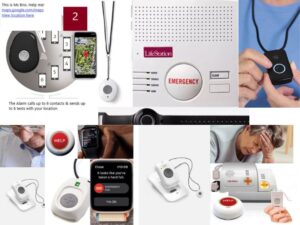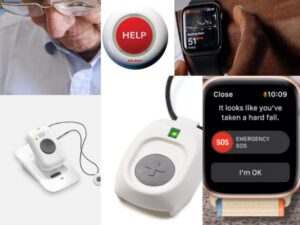Can Apple Watch be Used as a Medical Alert?
Yes, Apple Watch can be used as a medical alert device in some situations. The Apple Watch includes a built-in feature called Emergency SOS, which can be activated by pressing and holding the side button on the device.
Once activated, the watch will make a loud noise and display an emergency countdown screen. If the user continues to hold the side button, the watch will automatically contact emergency services and share the user’s location with them.

In addition to the Emergency SOS feature, there are also third-party apps available that can turn the Apple Watch into a more traditional medical alert device. These apps typically require the user to pay a subscription fee and may offer additional features such as fall detection, heart rate monitoring, and medication reminders.
It is important to note that while the Apple Watch can be used as a medical alert device, it may not be appropriate for everyone. For example, the watch may not be ideal for individuals who are not comfortable using technology or who have significant cognitive impairments. It is also important to ensure that the watch is fully charged and that the Emergency SOS feature is set up correctly in order to ensure it works properly in the event of an emergency.
Features of the Apple Watch
The Apple Watch has several features that make it a potential option for a medical alert system. Some of these features include:
Fall Detection
The Apple Watch Series 4 and later models have built-in fall detection capabilities. This feature uses the device’s sensors to detect a hard fall and can automatically initiate an emergency call if the user is unresponsive after the fall. This feature can be a lifesaver for seniors or individuals living alone at risk of falls.
Emergency SOS
The Emergency SOS feature allows users to quickly call for help by pressing and holding the side button on their Apple Watch. This feature can also be triggered by performing a series of taps and swipes on the device’s screen. Once activated, the Emergency SOS feature can contact emergency services and notify your emergency contacts.
Medical ID
The Medical ID feature on the Apple Watch allows users to store important medical information, such as their blood type, allergies, and emergency contacts. Emergency responders can access this information even if the device is locked.
Heart Rate Monitoring
The Apple Watch has a built-in heart rate monitor that can track your heart rate throughout the day. This feature can be especially useful for individuals with heart conditions or those who want to monitor their heart rate during exercise.

Noise Detection
The Noise app on the Apple Watch can detect when the ambient noise levels are too high and potentially damage your hearing. This feature can help users take steps to protect their hearing and avoid potential health problems.
Pros and Cons of Apple Watch being Used as a Medical Alert
The Apple Watch has become a popular device for many people, offering features such as fitness tracking, messaging, and phone calls. However, the Apple Watch has also gained popularity as a medical alert device. While there are benefits to using the Apple Watch as a medical alert, there are also potential drawbacks.
Pros:
- Continuous Monitoring: One of the biggest benefits of using an Apple Watch as a medical alert is its ability to provide continuous monitoring. With heart rate monitoring and fall detection features, the Apple Watch can quickly detect potential medical issues and alert emergency services.
- Convenience: Using an Apple Watch as a medical alert is convenient, especially for those who don’t want to carry a separate device. Since many people wear an Apple Watch daily, using it as a medical alert device can be a seamless and natural addition to their daily routine.
- Customization: The Apple Watch can be customized to meet the user’s specific needs. For example, a person with a specific medical condition can set up alerts and notifications to ensure they are alerted to any potential issues.
Cons:
- Limited Range: While the Apple Watch can alert emergency services, its range is limited to the distance from the user’s phone. If the user is out of range from their phone, the Apple Watch may be unable to call for help.
- Battery Life: The Apple Watch’s battery life may be a potential issue, especially if it is used for medical alerts. If the battery runs out, the device may not be able to alert emergency services promptly.
- False Alarms: The Apple Watch’s fall detection feature has been known to trigger false alarms, which can be frustrating for both the user and emergency services. Additionally, since the Apple Watch relies on sensors, it may not accurately detect all falls or medical issues.
Using an Apple Watch as a medical alert has both pros and cons. While it offers continuous monitoring and customization, there are also potential issues with range, battery life, and false alarms. Ultimately, it is up to the individual to weigh the benefits and drawbacks and decide if using an Apple Watch as a medical alert is the right choice for them.
Frequently Asked Questions
Do I need an iPhone to use the Apple Watch as a medical alert device?
Yes, the Apple Watch requires an iPhone to function properly. The iPhone is used to set up the device, receive notifications, and make emergency calls.
Can I use the Apple Watch as a standalone medical alert system?
No, the Apple Watch requires an active cellular or Wi-Fi connection to make emergency calls. It cannot be used as a standalone medical alert system.
How accurate is the heart rate monitoring feature on the Apple Watch?
The heart rate monitoring feature on the Apple Watch is generally accurate but may not be as accurate as a professional medical device. It is important to note that the Apple Watch is not a medical device and should not be used as a substitute for professional medical advice.
Can I customize the Emergency SOS feature on my Apple Watch?
Yes, you can customize the Emergency SOS feature on your Apple Watch by adding or removing emergency contacts and choosing whether to notify your emergency contacts when the feature is activated automatically.
How does the Medical ID feature on the Apple Watch work?
The Medical ID feature on the Apple Watch allows users to store important medical information that emergency responders can access. To set up your Medical ID, open the Health app on your iPhone and go to the Medical ID tab. From there, you can enter your medical information and emergency contacts.
Conclusion
The Apple Watch has several features that make it suitable for medical alert purposes. Its fall detection, Emergency SOS, Medical ID, heart rate monitoring, and noise detection features can help users stay safe and connected in an emergency. However, it is important to note that the Apple Watch is not a substitute for professional medical advice or a standalone medical alert system.
If you or a loved one are considering using an Apple Watch as a medical alert device, it is essential to have a backup plan in case of technological failures. For instance, consider having a landline phone or another medical alert device as a backup option.
The Apple Watch can be useful for alert medical purposes, thanks to its various features and advantages. However, it is important to use it with other measures to ensure maximum safety and emergency preparedness.
